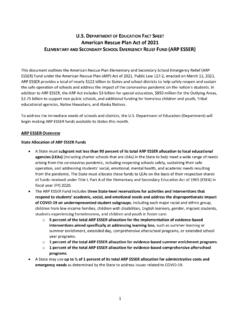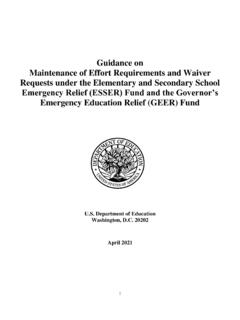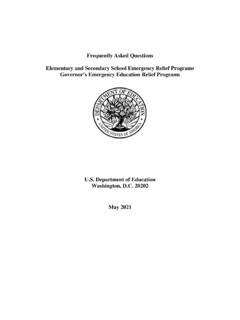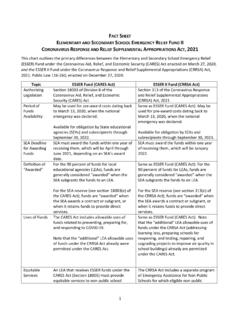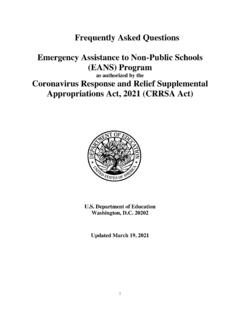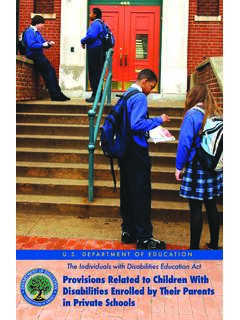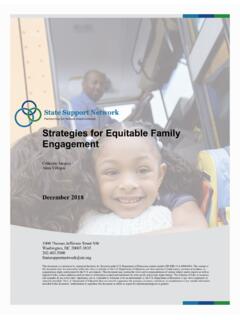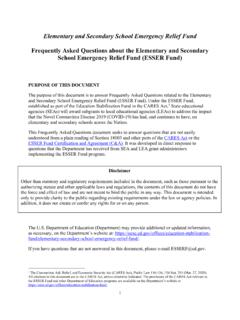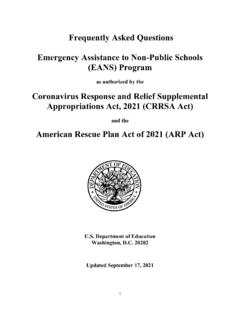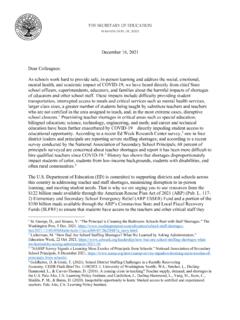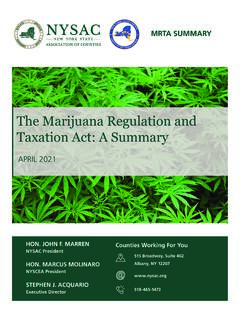Transcription of Guidance on Maintenance of Effort Requirements and Waiver ...
1 Guidance on Maintenance of Effort Requirements and Waiver Requests under the Elementary and Secondary School Emergency Relief (ESSER) Fund and the Governor's Emergency Education Relief (GEER) Fund Department of Education Washington, 20202. April 2021. 1. Department of Education Guidance on Maintenance of Effort Requirements and Waiver Requests The purpose of this Guidance is to provide information on the Maintenance of Effort (MOE) Requirements under the Elementary and Secondary School Emergency Relief (ESSER) Fund and the Governor's Emergency Education Relief (GEER) Fund. This Guidance document includes the following: A chart outlining the main similarities and differences between the MOE Requirements in the Coronavirus Aid, Relief, and Economic Security Act (CARES Act), the Coronavirus Response and Relief Supplemental Appropriations Act, 2021 (CRRSA Act), and the American Rescue Plan Act of 2021 (ARP Act). Frequently asked questions about the MOE Requirements and the process for states to request an MOE.
2 Waiver under section 2004(a) of the ARP Act. The Department's approach to MOE Waiver requests will be rooted in consideration of the impact on students. The purpose of ARP ESSER, ESSER I, ESSER II, GEER I, GEER II, and EANS funds is to expand resources for K-12 and postsecondary schools and students, not to replace existing State commitments to K-12 and postsecondary education. An MOE worksheet describing how to calculate MOE under the CARES Act, the CRRSA Act, and the ARP Act. An MOE data submission form that each State must use to report MOE data for the CARES Act, the CRRSA Act, and the ARP Act. An MOE Waiver request form that a State must use when requesting a Waiver of the MOE Requirements . In the near future, the Department will also release separate Guidance on the new State and local educational agency (LEA) Maintenance of equity Requirements in section 2004(b) and (c) of the ARP Act. 2. OMB Control #: 1810-0745.
3 Expiration Date: October 31, 2021. Comparing the Maintenance of Effort Requirements in the CARES Act, the CRRSA Act, and the ARP Act1. This chart outlines the main similarities and differences between the Maintenance of Effort (MOE) Requirements in the Coronavirus Aid, Relief, and Economic Security Act (CARES Act), the Coronavirus Response and Relief Supplemental Appropriations Act, 2021 (CRRSA Act), and the American Rescue Plan Act of 2021 (ARP Act). The MOE Requirements for the CRRSA Act and the ARP Act are included in the same column because the Requirements under the two statutes are the same, except that the ARP Act extends the CRRSA Act Requirements for an additional fiscal year. Topic CARES Act (Section 18008) CRRSA Act (Division M, Section 317) &. ARP Act (Section 2004(a)). Programs Elementary and Secondary School CRRSA Act: ESSER II, GEER II, Subject to Emergency Relief Fund (ESSER), Emergency Assistance to Non-Public MOE Governor's Emergency Education Relief Schools (EANS) program.
4 Fund (GEER). ARP Act: ARP ESSER. The Requirements do not apply to ARP EANS. MOE A State that receives ESSER or GEER CRRSA Act: A State that receives ESSER. Requirements funds under the CARES Act must: II, GEER II, or EANS funds under the CRRSA Act must: 1. Maintain State support for elementary and secondary education in each of 1. Maintain State support for elementary fiscal years (FYs) 2020 and 2021 at and secondary education in FY 2022 at least at the level of such support that is least at the proportional level of the the average of State support for State's support for elementary and elementary and secondary education secondary education relative to the for FYs 2017, 2018, 2019; and State's overall spending, averaged over FYs 2017, 2018, and 2019; and 2. Maintain State support for higher education in each of FYs 2020 and 2. Maintain State support for higher 2021 at least at the level of such education in FY 2022 at least at the support that is the average of State proportional level of the State's support for higher education for FYs support for higher education relative to 2017, 2018, and 2019.
5 The State's overall spending, averaged over FYs 2017, 2018, and 2019. 1. Other than statutory and regulatory Requirements included in the document, the contents of this Guidance do not have the force and effect of law and are not meant to bind the public. This document is intended only to provide clarity to grantees regarding existing Requirements under the law or agency policies. 3. Topic CARES Act (Section 18008) CRRSA Act (Division M, Section 317) &. ARP Act (Section 2004(a)). ARP Act: A State that receives ARP. ESSER funds must meet this MOE. requirement in each of FYs 2022 and 2023. MOE Baseline The CARES Act has two MOE baselines: The CRRSA Act and ARP Act have the Level same two MOE baselines: 1. Elementary and secondary education baseline, which averages the dollar 1. Elementary and secondary education amount of State support for elementary baseline, which averages the and secondary education over the percentages of total State spending three baseline years.
6 That are used to support elementary and secondary education over the 2. Higher education baseline, which three baseline years. averages the dollar amount of State support for higher education over the 2. Higher education baseline, which three baseline years. averages the percentages of total State spending that are used to support higher education over the three baseline years. Baseline years FYs 2017, 2018, and 2019. FYs 2017, 2018, and 2019. MOE years FY 2020 and FY 2021. CRRSA Act: FY 2022. ARP Act: FY 2022 and FY 2023. How to 1. Compare the dollar amount of State CRRSA Act: Demonstrate support for elementary and secondary MOE education for FY 2020 and separately 1. Compare the percentage of total State for FY 2021 to the baseline level on spending used to support elementary either an aggregate or per student and secondary education in FY 2022 to basis; and the baseline percentage; and 2. Compare the dollar amount of State 2.
7 Compare the percentage of total State support for higher education for FY spending used to support higher 2020 and separately for FY 2021 to the education in FY 2022 to the baseline baseline level on either an aggregate or percentage. full-time-equivalent (FTE) basis. ARP Act: Make these comparisons for both FY 2022 and FY 2023 relative to the baseline percentages. State Sources State support data: A State may use State support data: A State may use of MOE data either actual State expenditure data or data either actual State expenditure data or data representing final appropriated or allocated representing final appropriated or allocated 4. Topic CARES Act (Section 18008) CRRSA Act (Division M, Section 317) &. ARP Act (Section 2004(a)). amounts for both the baseline levels and amounts for both the baseline levels and the applicable comparison levels (FY 2020 the comparison levels (FY 2022 for and FY 2021). CRRSA Act, and FYs 2022 and 2023 for ARP Act).
8 State overall spending data: Not relevant for CARES Act MOE State overall spending data: A State must determination. use data on actual State expenditures to demonstrate overall spending, consistent with the statutory reference to overall State spending. A State may not use final appropriated or allocated amounts that differ from actual State expenditures to demonstrate compliance with the MOE. Requirements . MOE Data Baseline data: Each State submitted Baseline data: Each State must submit submission baseline data by September 1, 2020. baseline data by May 17, 2021. dates FY 2020 data: Each State submitted FY FY 2022 data: Each State must submit FY. 2020 data by December 31, 2020. Baseline 2022 interim data on appropriated or data and FY 2020 data may be updated by allocated amounts for State support for a State on or before May 17, 2021. elementary and secondary education, State support for higher education, and overall FY 2021 data: The Department intends to State spending by December 30, 2021.
9 Collect FY 2021 data by December 30, Each State must submit final expenditure 2021. data for FY 2022 overall State spending in spring 2023. FY 2023 data: Each State must submit FY. 2023 interim data on appropriated or allocated amounts for State support for elementary and secondary education, State support for higher education, and overall State spending by December 30, 2022. Each State must submit final expenditure data for FY 2023 overall State spending in spring 2024. 5. 1. What is meant by the term fiscal year in determining MOE? For purposes of determining MOE, a State may use either the applicable federal fiscal year or the applicable State fiscal year. Fiscal years are denoted by the calendar year in which they end ( , the fiscal year that ends June 30, 2021 would be deemed fiscal year 2021). See chart below for an example of how State and federal fiscal years align with particular school years. federal fiscal year State fiscal year (example) School Year FY 2020 October 1, 2019 - September 30, 2020 July 1, 2019 - June 30, 2020 2019-2020.
10 FY 2021 October 1, 2020 - September 30, 2021 July 1, 2020 - June 30, 2021 2020-2021. FY 2022 October 2, 2021 - September 30, 2022 July 1, 2021 - June 30, 2022 2021-2022. FY 2023 October 2, 2022 - September 30, 2023 July 1, 2022 - June 30, 2023 2022-2023. 2. How does a State quantify the amount of its support for elementary and secondary education? The CARES Act, CRRSA Act, and ARP Act do not specify how a State must determine its support for elementary and secondary education for purposes of the MOE Requirements , and the Department is not defining this term through regulation. Rather, in recognition of the variations in education finance data and the lack of a statutory definition, the Department is providing states with principles that provide flexibility in quantifying the amount of that support. In quantifying its support for elementary and secondary education, the data used by a State to determine the level of support must.
